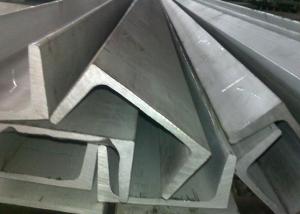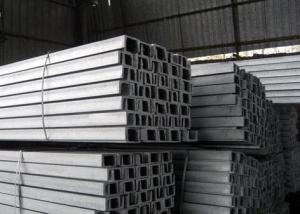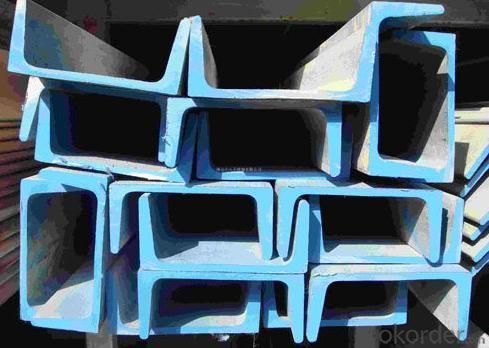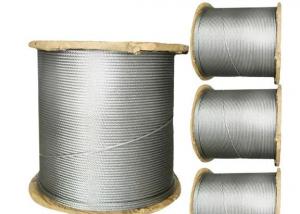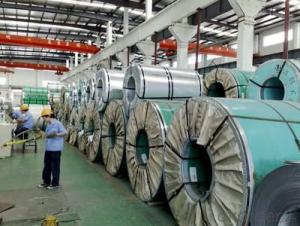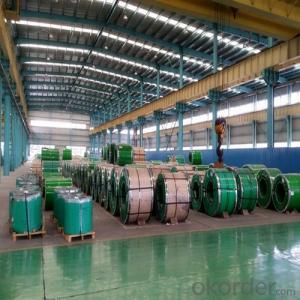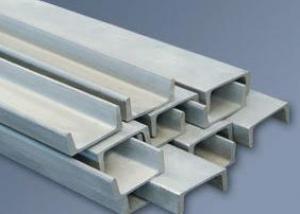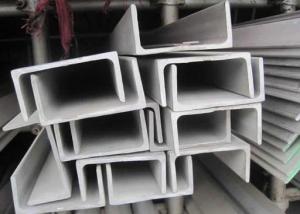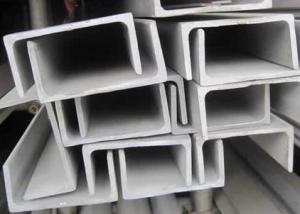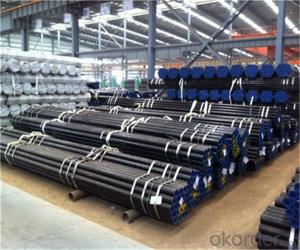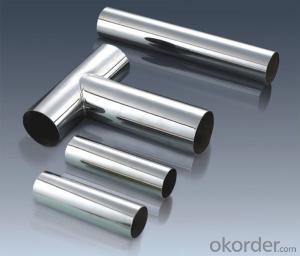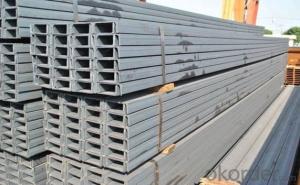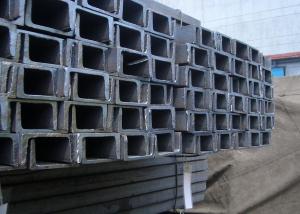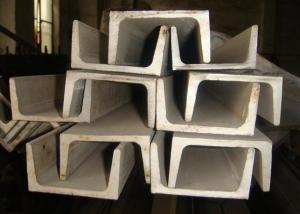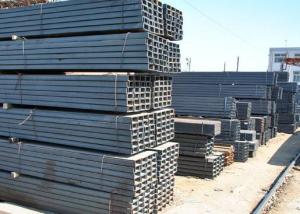Best Quality for 304 Stainless Steel Channels
- Loading Port:
- China Main Port
- Payment Terms:
- TT or LC
- Min Order Qty:
- 5 Tons m.t.
- Supply Capability:
- 1000 Tons Per Month m.t./month
OKorder Service Pledge
OKorder Financial Service
You Might Also Like
Stainless Steel Channels
General Informaiton of Stainless Steel Channels
Stainless Steel Channel, is ideal for all applications where greater strength and superior corrosion resistance is required.
Stainless Channel has a durable dull, mill finish that is widely used for all types of fabrication projects that are exposed to the elements - chemical, acidic, fresh water, and salt water environments.
The standard length for most size channel is 12’-14’ random lengths, but lengths are available in some sizes up to 20’ and longer.
Finishes on channel can vary and include cold drawn, center less ground; smooth turned, rough turned, turned ground and polished, and HRAP.
1. We will custom saw cut to length
2. DEFARS or domestic material available in many sizes
3. Polishing services are available
Spefification of Stainless Steel Channels
Product Name | Stainless Steel Channel |
Standard | JIS, ASTM, GB, DIN, EN, AISI |
Grade | 301,302,303,304,304L,305,309S,310S,316,316L,317,317L,321,347 631... |
Diameter | 75x30x6mm many other sizes can be done |
Length | 1m~6m |
Package Detail | Export standard package, bundled or be required. The inner size of container is below: 20ft GP: 5.9m(length) x 2.13m(width) x 2.18m(high) about 24-26CBM 40ft GP: 11.8m(length) x 2.13m(width) x 2.18m(high) about 54CBM 40ft HG: 11.8m(length) x 2.13m(width) x 2.72m(high) about 68CBM |
Delivery Time | Normally according to the order quantity or upon negotiation |
Payment Terms | L/C, T/T |
Application | Food stuff, gas, metallurgy, biology, electron, chemical, petroleum, boilers, nuclear, energy, construction field, ships building industry, war and electricity industry, boiler heat exchanger, machinery and hardware fields and medical equipment, fertilizer, etc. |
Contact | Our products are very popular because of high-quality and reasonable prices. If you are interested in any of our products, please feel free to contact us for more information. |
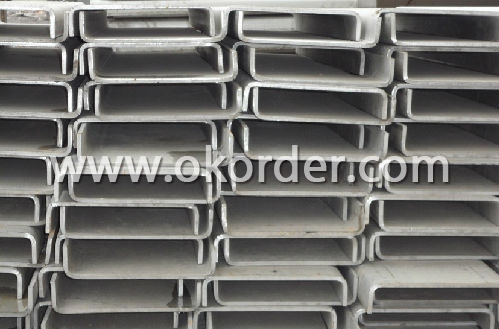

- Q: Can stainless steel channels be welded or joined together?
- Yes, stainless steel channels can be welded or joined together. Stainless steel is a highly weldable material and can be easily joined using various welding techniques such as TIG (Tungsten Inert Gas), MIG (Metal Inert Gas), or stick welding. These processes involve melting the stainless steel at the joint and adding a filler material to create a strong bond between the channels. Welding or joining stainless steel channels provides a secure and durable connection, making it suitable for various applications in construction, manufacturing, and engineering industries.
- Q: Can stainless steel channels be used in seismic zones?
- Yes, stainless steel channels can be used in seismic zones. Stainless steel is known for its excellent strength and durability, making it suitable for seismic applications. It has high tensile strength and resistance to corrosion, which allows it to withstand the forces and vibrations generated during seismic events. Additionally, stainless steel channels offer design flexibility and can be customized to meet specific seismic requirements, making them a reliable choice for construction in seismic zones.
- Q: Can stainless steel channels be used for supporting heavy-duty storage racks?
- Yes, stainless steel channels can be used for supporting heavy-duty storage racks. Stainless steel is known for its strength, durability, and corrosion resistance, making it an ideal choice for supporting heavy loads. The channels provide structural support and stability to the storage racks, ensuring that they can withstand the weight of heavy items without bending or collapsing. Additionally, stainless steel channels are easy to clean, which is important for maintaining hygiene in storage areas. Overall, stainless steel channels are a reliable and robust option for supporting heavy-duty storage racks.
- Q: Can stainless steel channels be used for modular construction?
- Yes, stainless steel channels can be used for modular construction. Stainless steel is a strong and durable material that offers excellent resistance to corrosion, making it suitable for various applications in modular construction. It provides structural support and can be easily fabricated and assembled to create modular units or systems. Additionally, stainless steel channels offer versatility, aesthetic appeal, and long-term sustainability, making them a viable choice for modular construction projects.
- Q: Can stainless steel channels be used for handrails or guardrails?
- Stainless steel channels have the capability to serve as handrails or guardrails. Given its durability and resistance to corrosion, stainless steel is a fitting material for both outdoor and indoor purposes. By utilizing these channels, a robust and reliable handrail or guardrail system can be established, ensuring safety and offering support. Moreover, stainless steel possesses an appealing aesthetic quality that can augment the overall ambiance of any given area.
- Q: Can stainless steel channels be used in the construction of food processing facilities?
- Yes, stainless steel channels can be used in the construction of food processing facilities. Stainless steel is highly resistant to corrosion, easy to clean, and has excellent hygienic properties, making it a suitable material for food processing environments. Stainless steel channels can be used for structural support, as well as for creating pathways for pipes, conduits, and other utilities in these facilities.
- Q: How do you determine the appropriate spacing for stainless steel channels in a structure?
- Determining the appropriate spacing for stainless steel channels in a structure involves considering several factors. Firstly, it is crucial to adhere to the manufacturer's guidelines and specifications for the particular stainless steel channels being used. These guidelines typically provide recommendations for the maximum allowable spacing between channels based on factors such as the load-bearing capacity of the channels and the expected loads on the structure. Additionally, the intended use and function of the structure should be taken into account. For example, if the structure is supporting heavy machinery or equipment, closer spacing between channels may be necessary to ensure adequate support and prevent deflection or failure. On the other hand, if the structure will not be subjected to heavy loads, wider spacing may be acceptable. It is also important to consult applicable building codes and standards, as they often provide specific requirements or recommendations for spacing of structural members like stainless steel channels. These codes consider factors such as the material properties, design loads, and safety factors to ensure structural integrity. Lastly, the expertise and experience of structural engineers or professionals involved in the design and construction of the structure play a crucial role in determining the appropriate spacing for stainless steel channels. They consider various engineering principles, such as the principles of structural analysis and design, to determine the optimal spacing based on the specific project requirements. In summary, determining the appropriate spacing for stainless steel channels in a structure involves considering manufacturer's guidelines, the intended use of the structure, applicable building codes, and the expertise of structural engineers. By considering these factors, an appropriate spacing can be determined to ensure the structural integrity and functionality of the stainless steel channels within the structure.
- Q: Are stainless steel channels available in standard lengths?
- Stainless steel channels can indeed be found in standard lengths. These standard lengths usually span from 6 to 12 feet, although they might differ depending on the manufacturer and supplier. It should be emphasized that tailored lengths can also be acquired by means of cutting or fabricating the stainless steel channels to accommodate specific project needs.
- Q: Are stainless steel channels suitable for outdoor signage?
- Yes, stainless steel channels are suitable for outdoor signage. Stainless steel is highly durable, corrosion-resistant, and weatherproof, making it an ideal material for outdoor applications. It can withstand harsh environmental conditions, including rain, sunlight, and extreme temperatures, ensuring the longevity and visibility of the signage. Additionally, stainless steel channels provide a sleek and modern aesthetic, making them a popular choice for outdoor signage.
- Q: Are stainless steel channels suitable for noise reduction applications?
- Stainless steel channels are indeed a fitting choice for applications focused on reducing noise. Renowned for their exceptional acoustic properties, including remarkable sound absorption and insulation capabilities, stainless steel is highly regarded. These channels find utility in diverse noise reduction scenarios, such as constructing sound barriers, acoustic enclosures, and acoustic panels. With their enduring nature, resistance to corrosion, and capacity to endure high temperatures, stainless steel channels prove to be a dependable option for long-lasting noise reduction solutions. Moreover, these channels can be tailored to meet particular design specifications, enabling customization and maximizing noise reduction effectiveness.
Send your message to us
Best Quality for 304 Stainless Steel Channels
- Loading Port:
- China Main Port
- Payment Terms:
- TT or LC
- Min Order Qty:
- 5 Tons m.t.
- Supply Capability:
- 1000 Tons Per Month m.t./month
OKorder Service Pledge
OKorder Financial Service
Similar products
Hot products
Hot Searches
Related keywords
